Explore the latest news and find out what's on this month
Explore our learning offer for schools, families and community groups
Uncover the rich history of Elmbridge with our latest online exhibitions
Want to discover more about your local area?
Explore the latest news and find out what's on this month
Explore our learning offer for schools, families and community groups
Uncover the rich history of Elmbridge with our latest online exhibitions
Want to discover more about your local area?
The artist’s name was Robert Taylor Pritchett. Born in Whitechapel, London, on the 24th February 1828, nine years before Queen Victoria ascended the throne, he had exhibited at the Royal Academy from 1851. During the 1860s, Pritchett was on the staff of Punch – a popular magazine established in 1841, famed for its humorous illustrations and cutting satire and widely regarded as a proponent of the modern cartoon.
Throughout his life, Pritchett painted many watercolours of Royal functions, and published accounts of his visits to Holland in 1871 and Norway in 1878. He was, above all, a master of pen and ink sketches, and in his detailed black and white drawings of Esher it’s easy to see how he turned his hand to the expressive art of cartoon drawing. As one of the finest book illustrators of the Victorian period, Elmbridge Museum’s acquisition of 36 of Pritchett’s artworks in May 1985 attracted widespread attention. The addition of this beautiful set to our collection was reported across most local newspapers at the time.
Pritchett drew inspiration from everywhere in Esher – rolling open fields, trickling streams, hidden cobweb-filled corners, and local characters feature widely in his work.
This online exhibition brings together a huge selection of Pritchett’s sketches held in Elmbridge Museum’s collection, providing a fascinating insight into what life in Victorian Esher was like.
There had been a pub on this site since 1460, and the building which stands today was established in the 1700s as a coaching inn on the London to Portsmouth route.
Also shown is the commemorative water pump presented to the village by the Comte de Paris after honeymooning at Claremont in 1864.
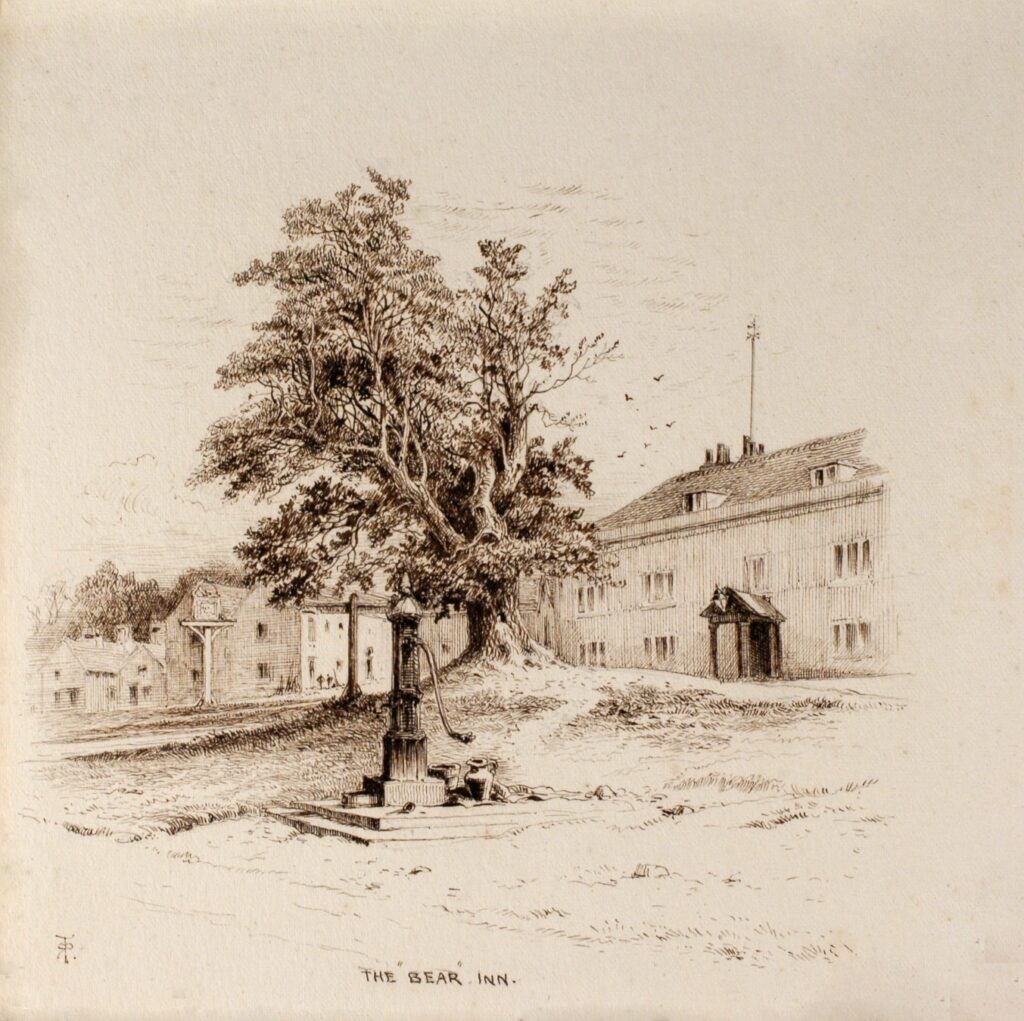 Pen and ink sketch of 'The Bear Inn', Esher, by Robert Taylor Pritchett, 1868.
Pen and ink sketch of 'The Bear Inn', Esher, by Robert Taylor Pritchett, 1868.
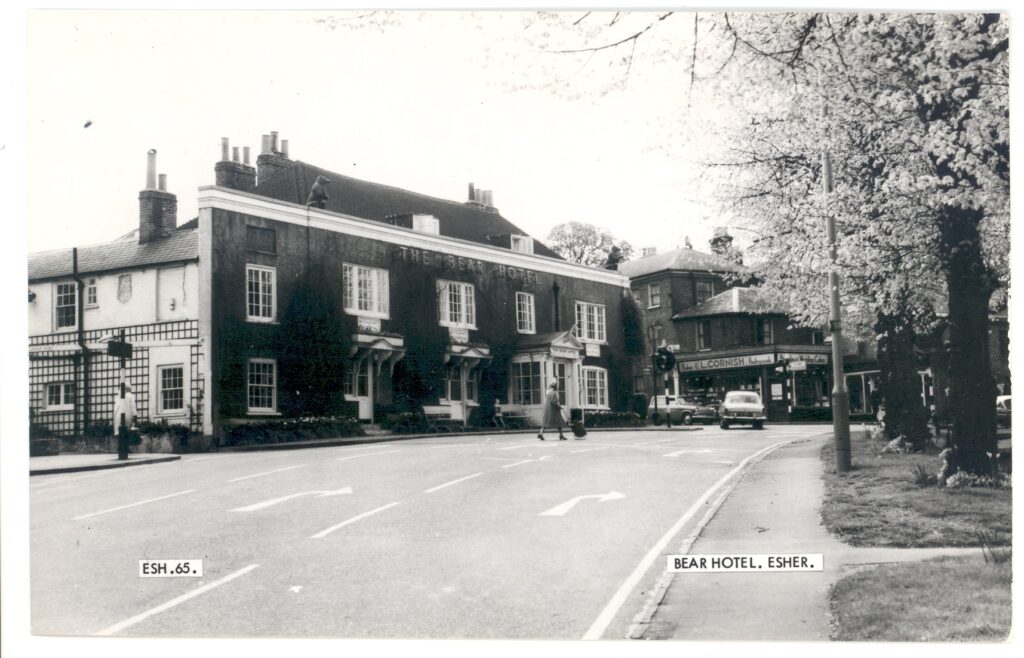 Postcard of the Bear Hotel, Esher, on the junction with Claremont Lane, 1950s-60s.
Postcard of the Bear Hotel, Esher, on the junction with Claremont Lane, 1950s-60s.
The flint and mortar Traveller’s Rest sits opposite the Civic Centre entrance, with its back to Sandown Park.
Known as ‘Wolsey’s Well’, it was built between 1730-40 by Henry Pelham, then owner of Esher Place and former British Prime Minister. It contains Pelham’s family emblem in the centre.
 Pen and ink sketch of 'The Traveller's Rest', Esher, by Robert Taylor Pritchett, 1868.
Pen and ink sketch of 'The Traveller's Rest', Esher, by Robert Taylor Pritchett, 1868.
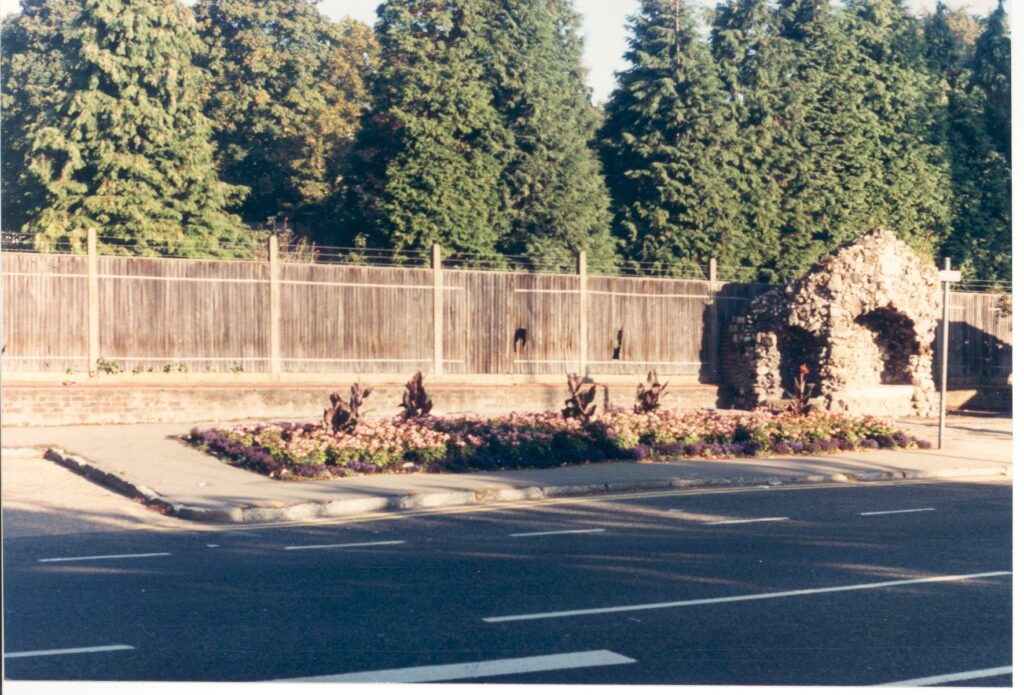 Photograph of the Traveller's Rest Grotto opposite Esher Council Offices, September 1987.
Photograph of the Traveller's Rest Grotto opposite Esher Council Offices, September 1987.
St. George’s Church sits behind The Bear Inn.
This Anglican church was built during the Reformation in the 1540s, and extended in the 1720s. It was used by royalty, including George IV’s daughter, Princess Charlotte, and Queen Victoria. The wooden clock-turret is original to the early 1600s.
Find out more about monuments inside the church here.
Learn more about the history of St. George's Church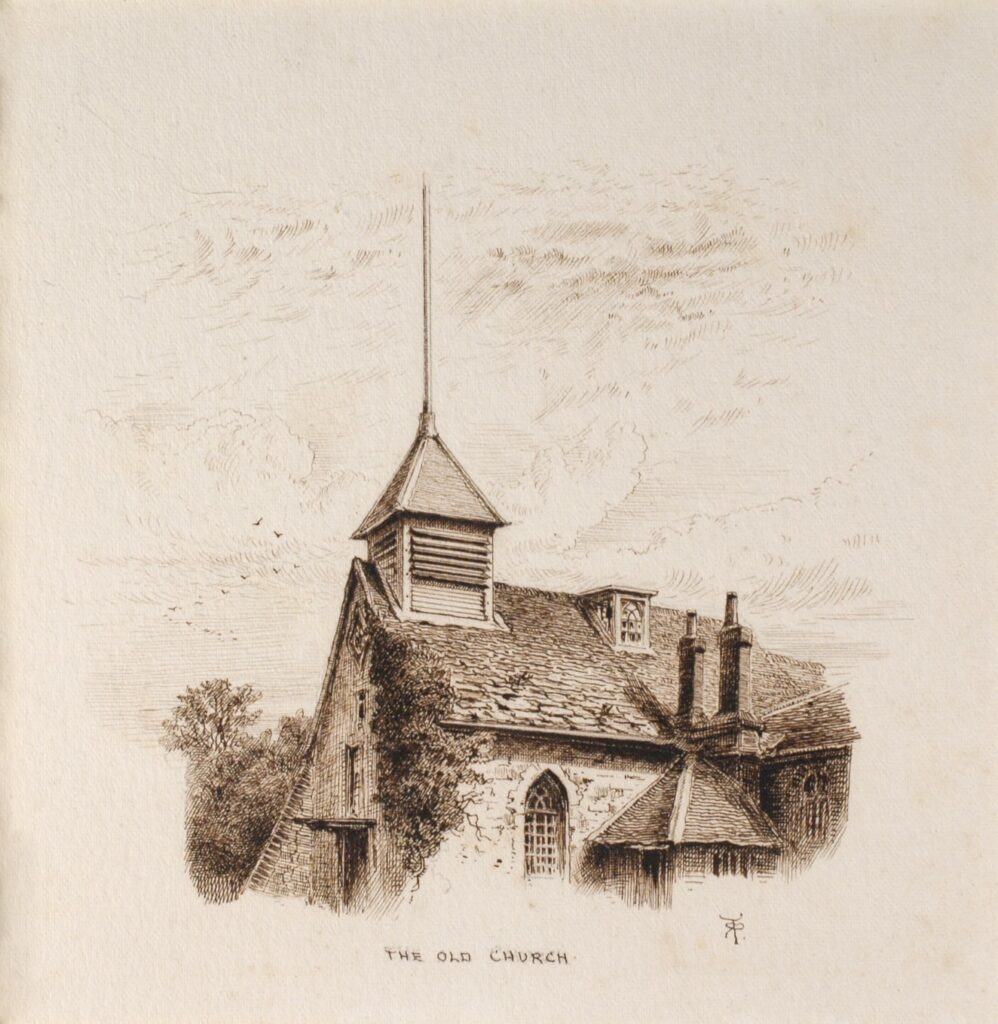 Pen and ink sketch of 'The Old Church', St. George's, Esher, by Robert Taylor Pritchett, 1868.
Pen and ink sketch of 'The Old Church', St. George's, Esher, by Robert Taylor Pritchett, 1868.
 Postcard of St. George's Church, Esher, taken from the road looking across the Bear Hotel's car park in the early 1960s.
Postcard of St. George's Church, Esher, taken from the road looking across the Bear Hotel's car park in the early 1960s.
 Pen and ink sketch of The Family Pew (in the 'Old Church', St. George's), Esher, by Robert Taylor Pritchett, 1868.
Pen and ink sketch of The Family Pew (in the 'Old Church', St. George's), Esher, by Robert Taylor Pritchett, 1868.
St. George’s Church became too small for the growing population of Esher in the Victorian era, and in 1853 it was replaced by the larger Christ Church on Esher Green. It was designed by Victorian architect Benjamin Ferrey, with a much grander exterior and a spire that was visible for miles.
The interior of the new church was impressive when it was built. To this day, it contains a number of historical features, including a beautiful Victorian organ and marble memorials to Queen Victoria’s uncle and son. The ‘Family Pew’ inside, sketched by Pritchett, was possibly that of the Spicer family of Esher Place.
Learn more about the history of Christ Church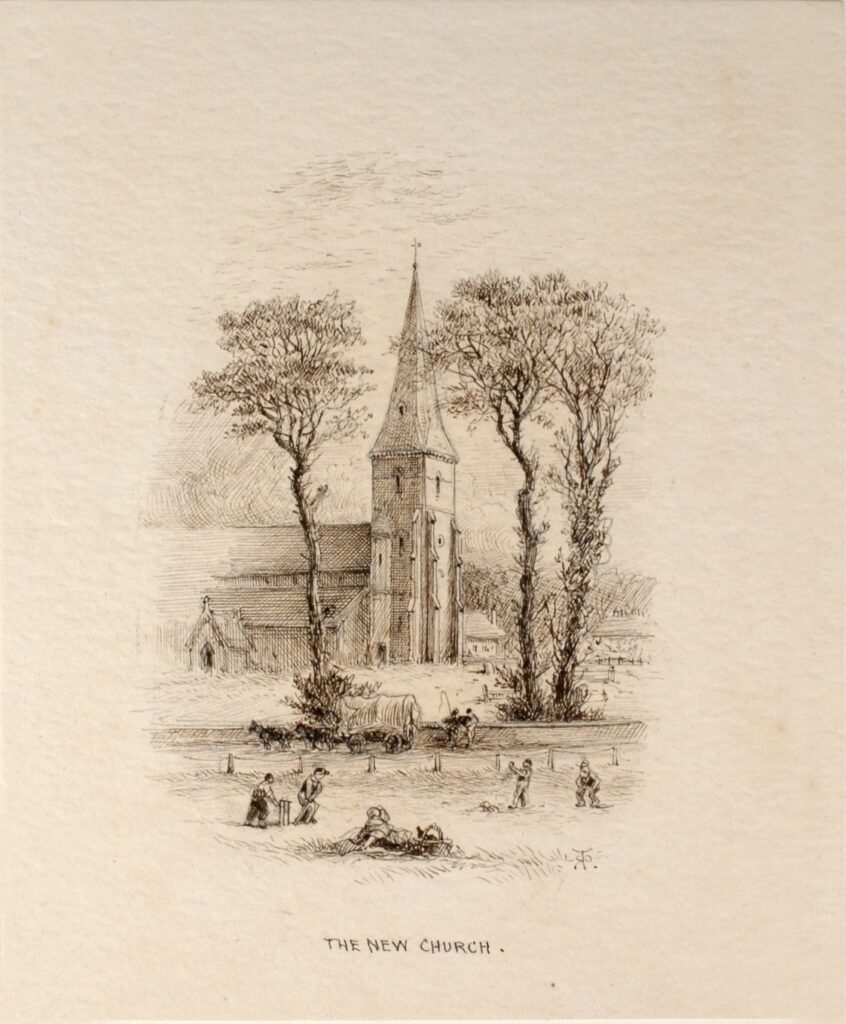 Pen and ink sketch of 'The New Church', Christ Church, Esher, by Robert Taylor Pritchett, 1868.
Pen and ink sketch of 'The New Church', Christ Church, Esher, by Robert Taylor Pritchett, 1868.
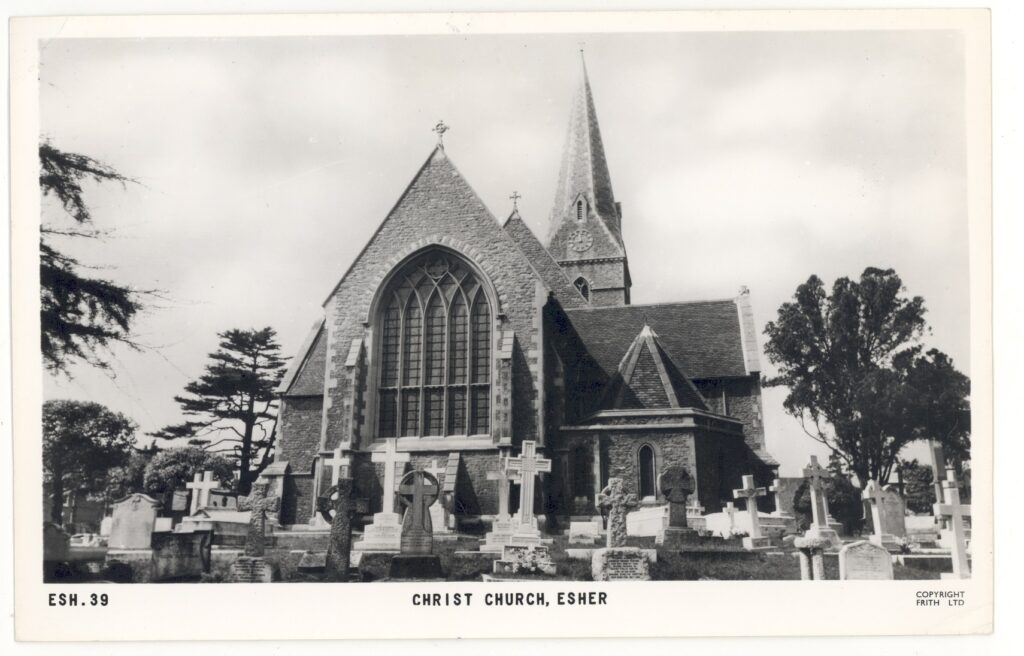 Postcard of Christ Church, Esher, taken from the road looking across the churchyard. 1950s - early 1960s.
Postcard of Christ Church, Esher, taken from the road looking across the churchyard. 1950s - early 1960s.
 Pen and ink sketch of The Family Pew (in the 'New Church', Christ Church), Esher, by Robert Taylor Pritchett, 1868.
Pen and ink sketch of The Family Pew (in the 'New Church', Christ Church), Esher, by Robert Taylor Pritchett, 1868.
Robert Taylor Pritchett didn’t begin life as an artist. As a young man, he had joined the Enfield gun makers to work under his father, successfully developing ‘the Pritchett Bullet’. But his fortunes were intrinsically linked to the changing circumstances of the British Empire, and the 1858 collapse of his employer’s main customer, the East India Company, prompted Pritchett to pursue an artistic career.
He did, however, remain a committed member of the Gunmakers’ Company throughout his life, and pursued his interest in this field by lecturing on gunlocks and rifles into old age. As an expert on armour, he helped to date many pieces in the collection at the Tower of London.
Pritchett also produced a wealth of sketches of the surrounding local countryside. We don't know exactly where this 'gate to the wood' was in Esher, as the area was then surrounded by woodland.
This colour photograph of the woodland at Esher Common, shows surrounding tall pine trees, and was taken in March 1981.
Here a back view of Esher Place can be seen from a bridge over the River Mole. This was probably Albany Bridge, a timber structure built in the mid-1800s. Replaced by a stone bridge in 1907, it is now roughly the location where the A244 crosses the Mole to connect Esher and Hersham.
This postcard of a photograph shows Albany Bridge on the left over the River Mole, looking from Hersham to Esher. It was taken in 1901. We know that Pritchett's sketch depicts this bridge because the latticework on the barrier is the same as in his sketch.
It is likely that this image also depicts the River Mole. A wooden footbridge can be seen leading over the water onto a large common in the background. In the Victorian era, Esher was a far more rural area than it is today, with lots of green space, woodland and open heathland.
This photograph shows the same 'still river' around 100 years after Pritchett. There is a man sitting under a tree fishing and two cyclists and a motor vehicle on the road. A wooden bridge can be seen over the river and there are cows in the field on the distant bank.
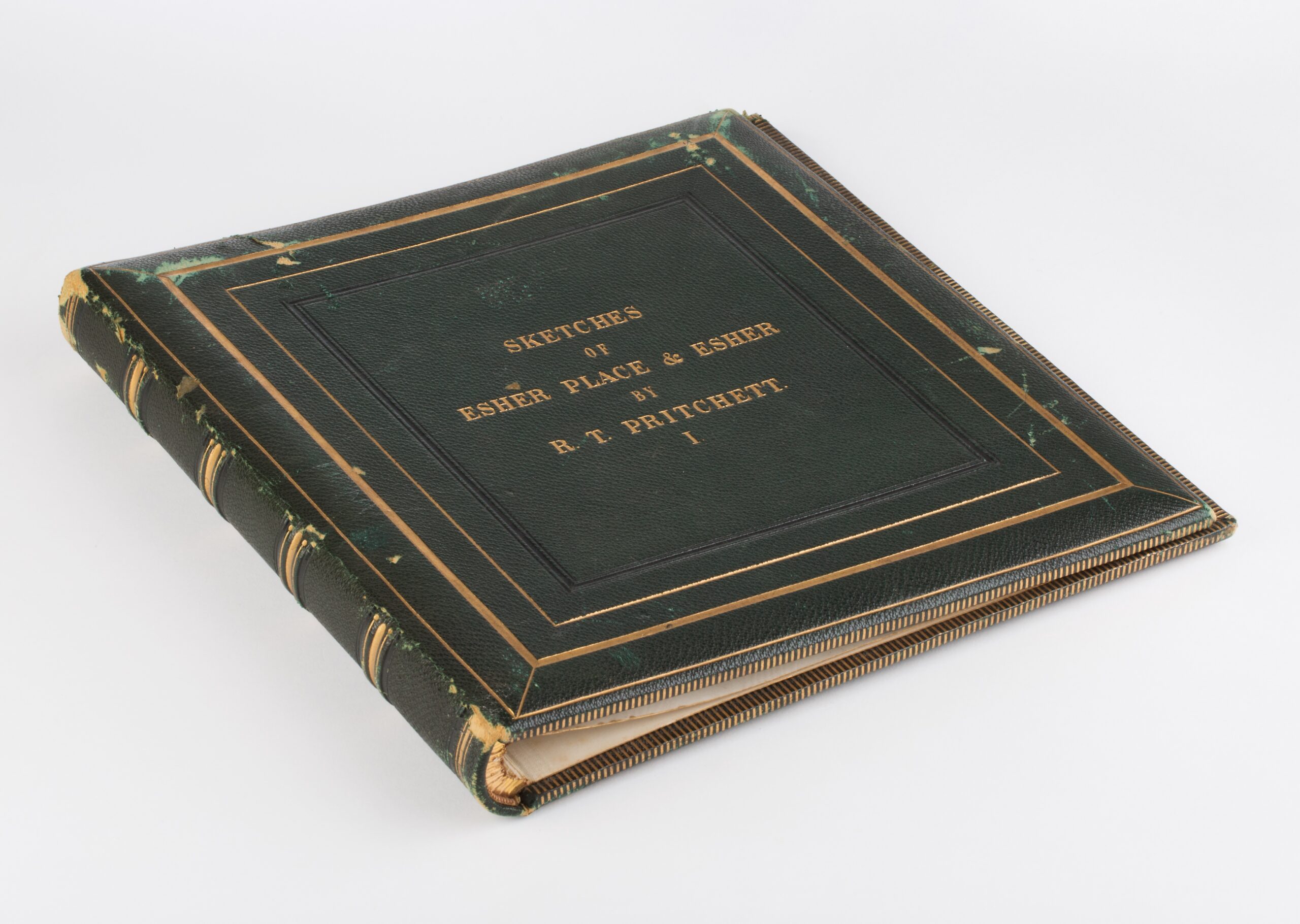 Sketches of Esher Place & Esher by R.T Pritchett, I’, bound in green leather.
Sketches of Esher Place & Esher by R.T Pritchett, I’, bound in green leather.
After marrying in September 1857, Robert Pritchett and his wife Louisa had a son and daughter. It was during the 1860s that they moved to Esher, living at ‘The New Lodge’ on Cato’s Hill, near Esher Green. Thanks to his repute as a royal artist and patronage by Queen Victoria, the Queen’s daughter Princess Louise and Lord Lorne actually visited Pritchett’s home in 1870.
This album is one of two formerly enclosing 36 of Pritchett’s pen and ink sketches. The artworks were removed from the original mounts, washed and re-mounted separately in acid free mounts by Fitzwilliam Museum, Cambridge, in 1986 and 1987, before being acquired by Elmbridge Museum.
This sketch depicts Wayneflete Tower, which was named after the builder, William Wayneflete, who constructed it in the 1400s. The Tower originally acted as the gatehouse to Esher Palace when approaching from the River Mole, and is all that remains of the original medieval structure. In 2005, Channel 4’s ‘Time Team’ dug the site to establish the original outline of the Palace, which had been destroyed in the late 1600s by Sir Thomas Lynch. He had replaced the Palace with a Jacobean property with three-storeys, for which the original Wayneflete Tower was at the heart.
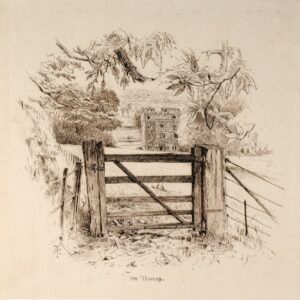
Pen and ink sketch of ‘The Towers’, by Robert Taylor Pritchett, 1868.

Pen and ink sketch of ‘The Towers’, by Robert Taylor Pritchett, 1868.

A photograph of Wayneflete Tower as seen from the river frontage, across the lawn, 1988.
The elderly man in this sketch, Bedo Philpot, sits by a fireplace, his shepherd’s staff hanging next to it on the cracked wall. The clock shows that it is 11 o’clock, giving the sense of a calm moment after returning from his morning shepherding. He is examining what appears to be a newspaper.
Read more about this sketch in our Object In Focus article
The exact location of this farm is unclear. It was possibly on the area redeveloped into ‘Old Farm Court’ in Lower Green. Victorian Esher, however, contained many farmhouses, and the sketch could also depict the medieval ‘Weston Manor Farm’ – on the site of what is now Esher College until 1962.
Esher formerly had many farms, some of which are pictured here.
 Pen and ink sketch of 'The Old Farm', by Robert Taylor Pritchett, 1868.
Pen and ink sketch of 'The Old Farm', by Robert Taylor Pritchett, 1868.
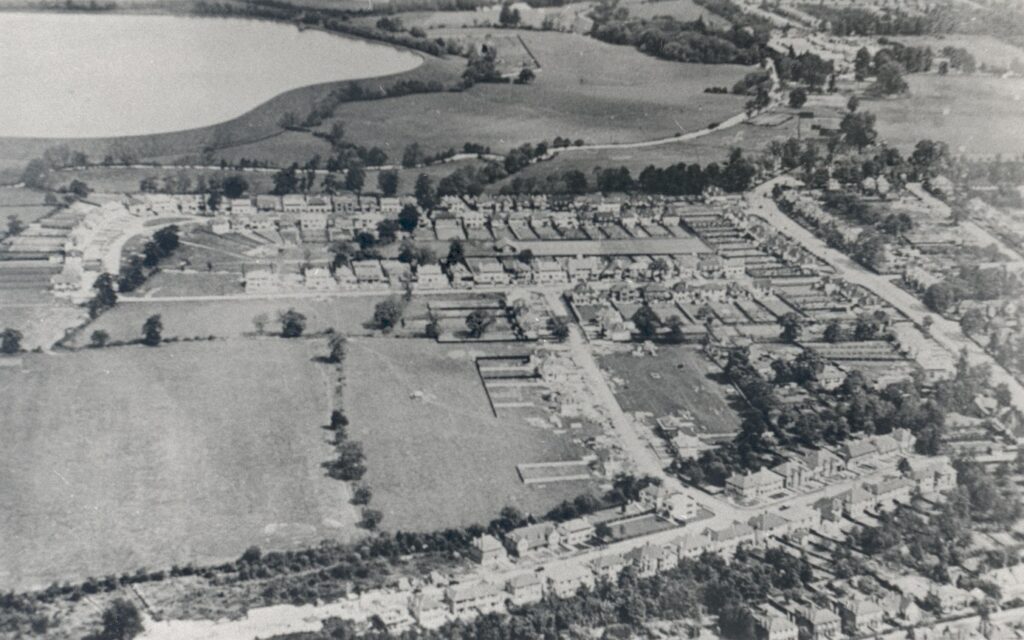 Copy of a postcard of the Pound Farm Estate in Esher, around 1930.
Copy of a postcard of the Pound Farm Estate in Esher, around 1930.
 A photograph of Hill House Farm on Portsmouth Road, Esher, taken in October 1967. The farm building has since been demolished.
A photograph of Hill House Farm on Portsmouth Road, Esher, taken in October 1967. The farm building has since been demolished.
Wool was one of Victorian Britain’s most important exports, so many farmers reared sheep for their wool. Sheep washes were designed to direct flocks through a fenced section of running water. They were used in early summer a few weeks before shearing, to clean dirt off the fleeces.
Although we do not have modern images of the sheep wash in Esher, we do have evidence of widespread sheep farming across the borough in the years after Pritchett’s residency in Esher.
 Pen and ink sketch of 'The Sheep Wash', by Robert Taylor Pritchett, 1868.
Pen and ink sketch of 'The Sheep Wash', by Robert Taylor Pritchett, 1868.
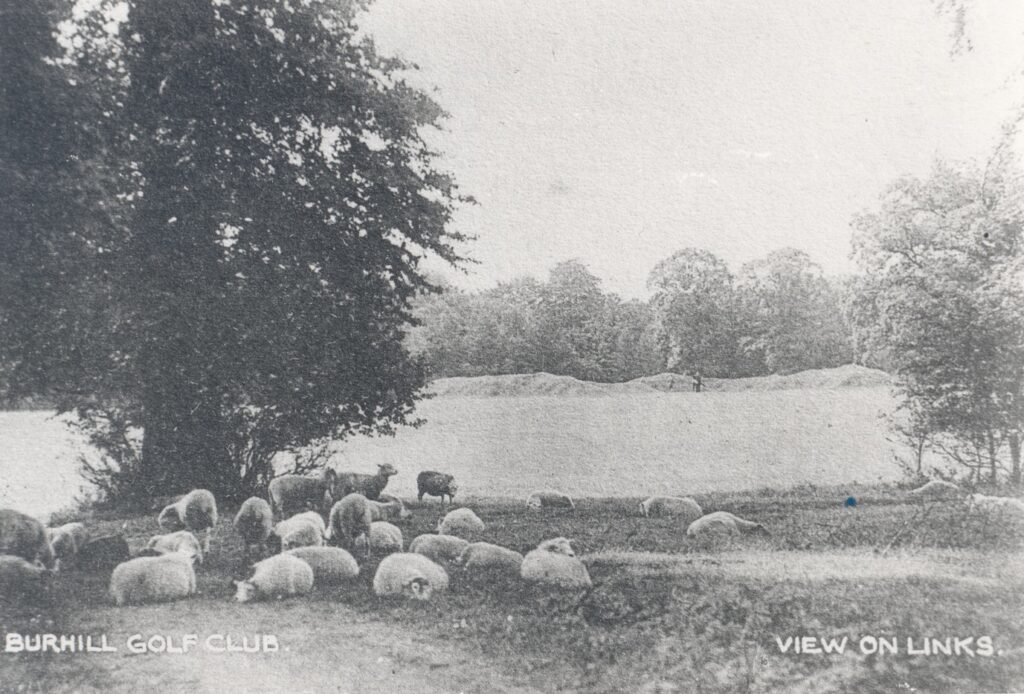 A copy of a postcard of 'Burhill Golf Club - View on Links', with a herd of sheep in the foreground, c. early-1900s.
A copy of a postcard of 'Burhill Golf Club - View on Links', with a herd of sheep in the foreground, c. early-1900s.
Queen Victoria gave Pritchett permission to draw her royal property of Claremont in 1868, and she subsequently bought some of his sketches of Esher. There are still many examples of Pritchett’s work in the Royal collection. In 1930, Claremont became a school and remains as such today.
This black and white photograph shows Claremont in 1900, the year before the death of Pritchett's wealthy patron Queen Victoria. Around 40 years after Pritchett's sketch was completed, it shows the drive and pillared entrance with steps much as it had been in Pritchett's day.
Less than a mile south of Claremont, Black Pond was originally used to supply water to the large estate’s gardens. Next to the waterfront in this sketch is the fishing house surrounded by woodland. Pine trees were widely introduced across Esher Common in the 1800s to provide timber.
This black and white photograph of a postcard of Black Pond shows it in 1909, just two years after Pritchett's death. It remains a popular feature of Esher Common today.
Explore the variety of important local people Robert Taylor Pritchett featured in his sketches by clicking each of the titles below. The sketches can tell us much about hierarchies of power within local Victorian communities.
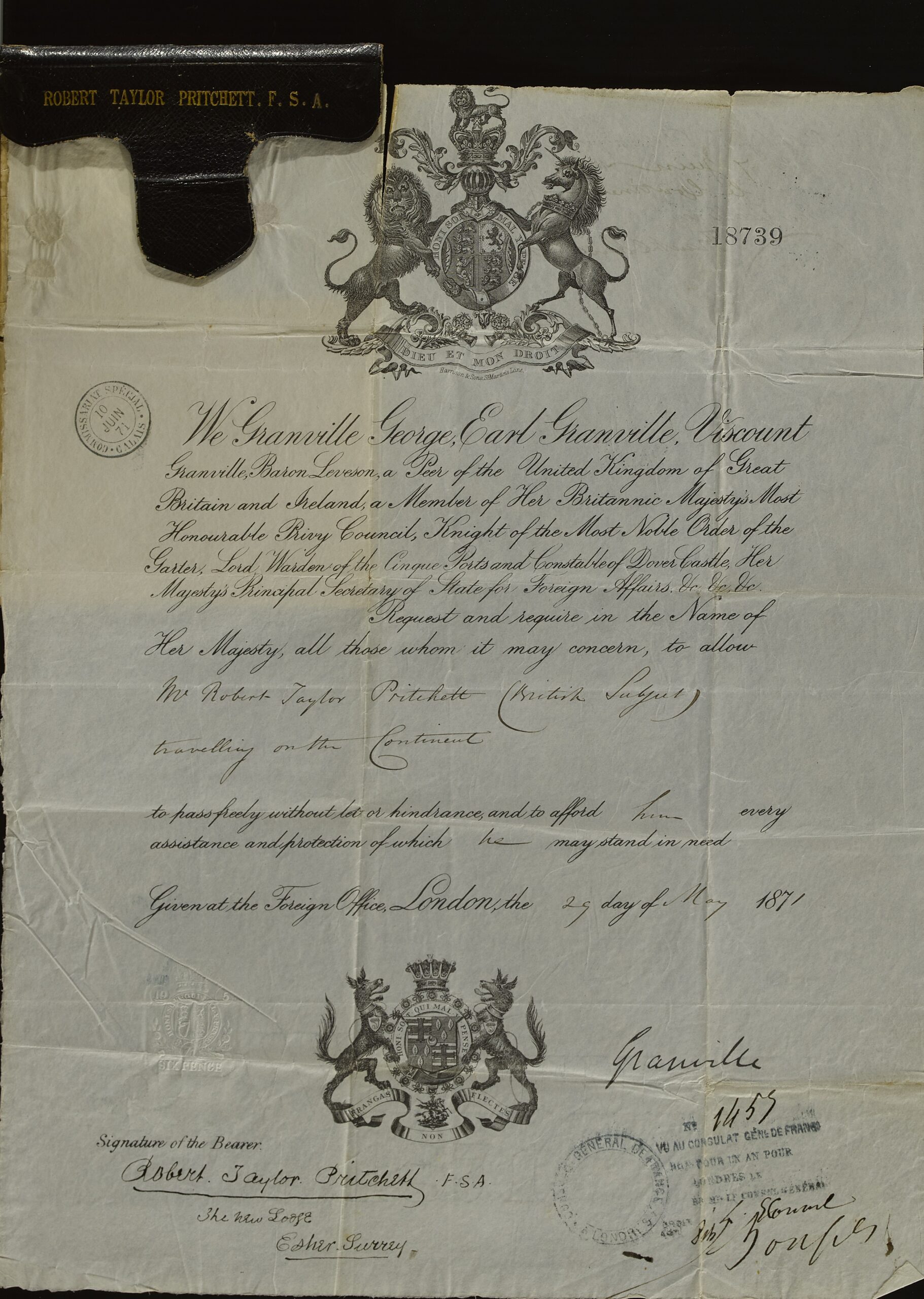 Robert Taylor Pritchett's passport. Inside the black leather case is a flimsy paper document allowing Pritchett's travel on the Continent, signed by him with the address The New Lodge, Esher, Surrey. It is dated 25th May 1871.
Robert Taylor Pritchett's passport. Inside the black leather case is a flimsy paper document allowing Pritchett's travel on the Continent, signed by him with the address The New Lodge, Esher, Surrey. It is dated 25th May 1871.
Robert Taylor Pritchett was commissioned to produce over 80 paintings of royal events during the Queen’s Jubilees in 1887 and 1897, as well as private royal events such as the christening of the daughter of Princess Beatrice and Prince Henry of Battenberg at Balmoral in 1887 – the granddaughter of Queen Victoria. With the death of Victoria in 1901 came the end of Pritchett’s royal patronage and previously huge income.
In later life, Pritchett also became a distinguished travel writer. Between the 1860s and 1880s, he visited the Netherlands, Norway, and then travelled around the world with high profile companions. Making the most of what he had seen on his travels, he published ‘British Notes on Holland’ in 1871, and illustrated many articles, books and accounts of various places around the world. This culminated in the 1890s, when Pritchett drew illustrations for Charles Darwin’s ‘Voyage of the Beagle’, for which he recommended himself for the job in a letter to the publishers expressing his awareness of the prestige of Darwin’s name amongst the public and his own abundant experience of travelling. There is no better demonstration of Pritchett’s travel experience than his passport, dated 25th May 1871 and now held in the Elmbridge Museum collection. This consists of a black leather case, with Pritchett’s name tooled in gold on the front. Inside is a flimsy paper document allowing R.T. Pritchett’s travel on the Continent, signed by him with the address ‘The New Lodge, Esher, Surrey’.
Pritchett died on 16th June 1907 in Burghfield, Berkshire, aged 79, having outlived his wife and both of his children.
Get to know the history of the whole borough in more detail by exploring our Local History Timeline.
Go to the timeline
Leave a Comment
We'd love to know what you thought of this online exhibition, or if you have your own memories of Esher.You need to be logged in to comment.
Go to login / register